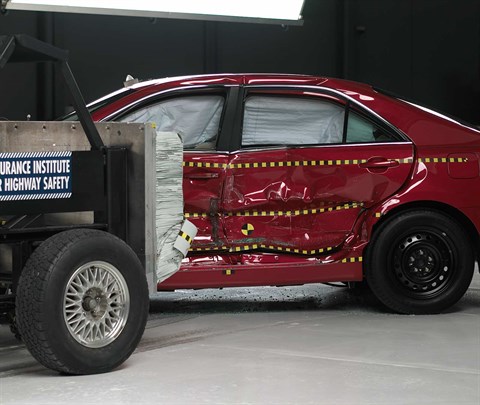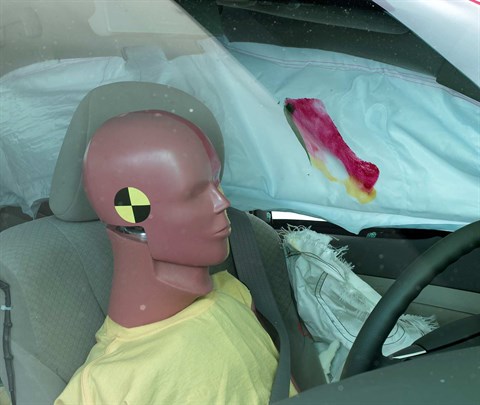Moderate overlap front: original test
Rating applies to 2007-11 models
Tested vehicle: 2007 Toyota Camry LE 4-door
The Toyota Camry was redesigned for the 2007 model year. Frontal ratings are assigned by the Institute based on a test conducted by Toyota. The Camry was redesigned again for the 2012 model year, so these ratings do not apply to 2012 models.
The frontal offset crash test ratings also apply to the Lexus ES 350, the midsize luxury/near luxury version of the Camry, beginning with 2007 models and continuing through the 2012 models, which were not redesigned.
| Evaluation criteria | Rating |
|---|---|
| Overall evaluation | |
| Structure and safety cage | |
| Driver injury measures | |
| Head/neck | |
| Chest | |
| Leg/foot, left | |
| Leg/foot, right | |
| Driver restraints and dummy kinematics | |
Side: original test
Rating applies to 2007-11 models
Tested vehicle: 2007 Toyota Camry LE 4-door with standard front and rear head curtain airbags and standard front seat-mounted torso airbags
The Toyota Camry was redesigned for the 2007 model year. The Camry was redesigned again for the 2012 model year, so these ratings do not apply to 2012 models.
The side impact crash test ratings also apply to the Lexus ES 350, the midsize luxury/near luxury version of the Camry, beginning with 2007 models and continuing through the 2012 models, which were not redesigned.
| Evaluation criteria | Rating |
|---|---|
| Overall evaluation | |
| Structure and safety cage | |
| Driver injury measures | |
| Head/neck | |
| Torso | |
| Pelvis/leg | |
| Driver head protection | |
| Rear passenger injury measures | |
| Head/neck | |
| Torso | |
| Pelvis/leg | |
| Rear passenger head protection | |

View of the vehicle and barrier just after the crash test.

View of the vehicle after the crash with doors removed, showing the side airbags and damage to the occupant compartment.

Smeared greasepaint shows where the driver dummy's head was protected from being hit by hard structures by the side curtain airbag.

Smeared greasepaint shows where the rear passenger dummy’s head was protected by the side airbag.
Roof strength
Rating applies to 2007-11 models
Tested vehicle: 2010 Toyota Camry LE 4-door
| Overall evaluation | |
|---|---|
| Curb weight | 3,315 lbs |
| Peak force | 17,588 lbs |
| Strength-to-weight ratio | 5.31 |
Head restraints & seats
Seat type: Power cloth seats built after March 2007
| Overall evaluation | |
|---|---|
| Dynamic rating | |
| Seat/head restraint geometry |
About the head restraint & seat test
Currently, IIHS tests apply only to front seats.
